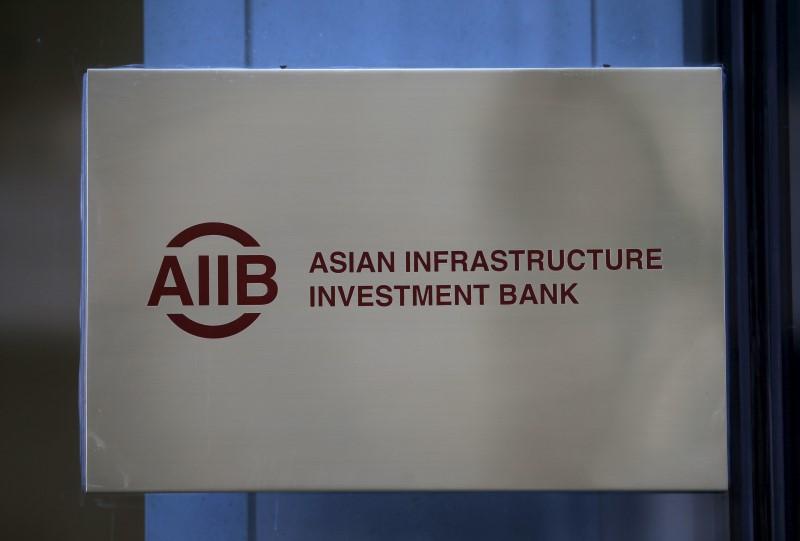
The signboard of Asian Infrastructure Investment Bank (AIIB) is seen at its headquarter building in Beijing January 17, 2016. | PHOTO: REUTERS/Kim Kyung-Hoon
The Philippines will borrow $100 million (about P5.1 billion) from the Beijing-based Asian Infrastructure Investment Bank (AIIB) to roll out flood control and water disaster resiliency projects at river basins in northern Luzon and Mindanao.
A Jan. 27 document of the China-led AIIB showed that the Department of Finance (DOF) will borrow on behalf of the Philippine government for the integrated flood resilience and adaptation project 1 to be implemented by the Department of Public Works and Highways (DPWH).
The project will be co-financed by the AIIB and the Manila-based Asian Development Bank (ADB). The ADB will extend a bigger $211-million concessional loan while the government will shell out $79.9 million from the national budget to finance the total project cost of $391.58 million.
The ADB’s high-level technology fund grant will also contribute a $680,000 assistance to the project.
The AIIB chunk of the proposed financing will cover the river basins of Abra in Luzon as well as Agus (Ranao) and Tagum-Ligubanon in Mindanao. Separate ADB documents showed that three other river basins will be included in the project: Apayao-Abulog in Luzon, Jalaur in Visayas, and Buayan-Malungon in Mindanao.
The DPWH project was aimed at reducing flood risks in these river basins while enhancing flood and climate change resilience in the surrounding communities.
The AIIB said its forthcoming financing “will contribute to the improvement of the national flood risk management by strengthening the institutional and technical capacity of key governmental agencies, both at the central and regional level, and local communities, and by investing in the rehabilitation and construction of flood protection infrastructures.”
Specifically, the upcoming AIIB loan will finance strategic flood risk management planning; building of flood protection infrastructure; and community-based flood risk management.
“Consultations have been carried out and are ongoing, in the three river basins” to be covered by the AIIB loan, it said.
The AIIB acknowledged environmental and social impacts of the project, especially among households living near riverbanks and flood-prone areas.
“The project’s potential environmental impacts are associated with the construction of the physical works. These works are small in scale, occurring within modified agricultural landscapes, mostly away from settlements and sensitive receptors. These potential impacts are typically localized, short-term and small in scale, and can be effectively mitigated through the application of appropriate construction practices,” the AIIB said.
“The project’s structural measures have anticipated impacts that include: permanent loss of land, loss/damage to structures, loss of crops and trees, loss of income/business, restriction to access to resources, increased vulnerability, temporary loss or disruption of land use or other assets during construction works particularly due to the movement of construction materials to and from work sites, and impacts to indigenous peoples/ethnic groups. Corresponding management plans are being prepared to address both land acquisition impacts as well as impacts on indigenous people/ethnic group communities,” the bank added.
Once approved in December 2022, this will be the Philippines’ fifth AIIB loan, and the second flood control project financing. The three other loans totaling $1.3 billion, for projects also co-financed by the ADB, were for COVID-19 response, including the purchase of vaccines, boosters and pediatric shots.
In November 2021, the AIIB flagged the still sluggish disbursement of its $207.6-million loan for the Metro Manila flood management project.
“Project implementation has been progressing slower than originally agreed timelines. The COVID-19 pandemic has significantly impacted the project progress, particularly procurement process since March 16, 2020,” the AIIB said.
The AIIB nonetheless said that construction of Balut pumping station had been completed and it “functioned well” when typhoon “Ulysses” battered the country in November 2020.
In the current fourth quarter of 2021, contracts for Labasan and Paco pump stations were expected to be awarded, and “procurement will be followed shortly for remaining pumping stations,” the AIIB said.
Following the latest disbursement of $4.2 million last July, a total of just $10.9 million or merely 5.3 percent of the AIIB’s commitment had been disbursed since the loan was approved in 2017.
The AIIB, the World Bank, and the Philippine government have been co-financing the $500-million project currently jointly implemented by the Department of Public Works and Highways (DPWH) and the Metropolitan Manila Development Authority (MMDA).
This project would protect 1.7 million residents near 56 “potentially critical” drainage systems across 11,110 hectares of flood-prone areas in Metro Manila. Upon project completion in 2024, these areas should be free of water within 24 hours after a major rainfall.

